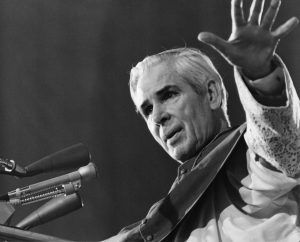“He is home” — Archbishop Sheen’s remains transferred to Peoria, cause reopened
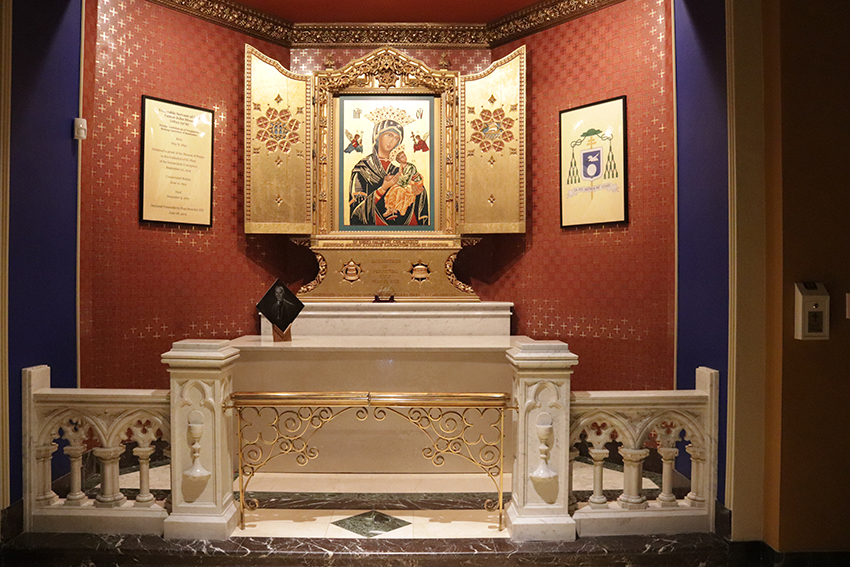
The casket bearing the remains of Venerable Archbishop Fulton Sheen rests within the new marble tomb prepared for him in the Cathedral of St. Mary of the Immaculate Conception on June 27. Archbishop Sheen was ordained in the cathedral in 1919 and consecrated himself to the Blessed Mother there. (The Catholic Post/Jennifer Willems)
As a small group of witnesses silently looked on, the mortal remains of Venerable Archbishop Fulton J. Sheen were interred at St. Mary’s Cathedral in Peoria late in the afternoon of June 27, completing a transfer from St. Patrick’s Cathedral in New York that began early that morning.
Bishop Daniel R. Jenky, CSC, of Peoria was among those present as the casket arrived by hearse shortly after 5 p.m. at the cathedral where Archbishop Sheen was ordained a priest of the Diocese of Peoria nearly a century ago. Bishop Jenky blessed with holy water a container holding the casket as it was carried up the cathedral steps by nine seminarians and again after it was placed in a new tomb in front of an icon of Our Lady of Perpetual Help.
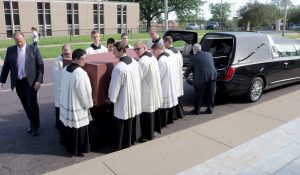
Seminarians of the Diocese of Peoria, led by Phillip Lee, director of the Office of Divine Worship, carry the container with the casket of Venerable Archbishop Fulton Sheen from the hearse to the steps of St. Mary’s Cathedral in Peoria. (The Catholic Post/Jennifer Willems)
Earlier in the day, Bishop Jenky announced that the sainthood cause for the famed preacher, media pioneer, author and missionary had resumed after being suspended for five years pending the resolution of a legal dispute over the location of Archbishop Sheen’s remains. (See full news release here.) Since his death on Dec. 9, 1979, at the age of 84, Archbishop Sheen had been interred in a basement crypt under the main altar of St. Patrick’s Cathedral.
Diocese of Peoria officials are hopeful that Pope Francis will soon be presented with evidence of an alleged miracle attributed to Archbishop Sheen’s intercession. Already approved by medical experts and theological advisers to the Vatican’s Congregation for the Causes of Saints, it involves the healing in 2010 of a newborn infant who was without vital signs for more than 60 minutes.
Authentication of the miracle by Pope Francis could then lead him to call for Archbishop Sheen’s beatification. Bishop Jenky encouraged prayers for Archbishop Sheen’s cause and expressed the hope that a beatification ceremony could be scheduled in Peoria during the 100th anniversary year of Archbishop Sheen’s priestly ordination. Archbishop Sheen was ordained in St. Mary’s Cathedral on Sept. 20, 1919.
Present at both the disinterment of her uncle’s remains in New York and their arrival at the cathedral in Peoria was Joan Sheen Cunningham, Archbishop Sheen’s closest living relative who petitioned the New York court system for the transfer in 2016. Efforts by the Archdiocese of New York and the trustees of St. Patrick’s Cathedral to block the transfer ended when the New York Court of Appeals rejected their final appeal on June 7. The archdiocese has since cooperated with the Diocese of Peoria in ensuring the transfer followed both civil law and church law.
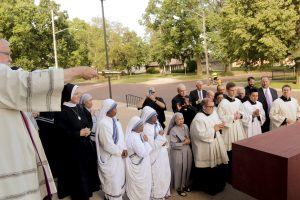
Bishop Jenky sprinkles holy water on the casket of Venerable Archbishop Fulton J. Sheen as the seminarians of the Diocese of Peoria prepare to carry it into St. Mary’s Cathedral in Peoria on June 27. (The Catholic Post/Jennifer Willems)
Among the church law requirements was that the transfer be done without any solemnity. It was not publicized in advance, and no liturgical ceremony or public gathering took place during the transfer. However, after the interment was completed, Bishop Jenky did lead the small group of priests, women religious, and diocesan officials present in a song to the Blessed Mother.
“Let us conclude as I know Fulton Sheen would want us to,” said Bishop Jenky as he began to sing the “Salve Regina.”
“I thought everything done here was perfect, just perfect,” said Cunningham moments later. “Very reverent. I know my uncle would like it, and I’m sure he’s sleeping very peacefully.” While Cunningham and her son, Paul — who was also present — both now live in New York, she noted Archbishop Sheen “has a tremendous amount of family” in his native Peoria area who are pleased at the return of his remains and the effort the Diocese of Peoria has made to that end.
While the events surrounding the transfer were kept private and discreet, the public was invited to visit the tomb starting the following day, June 28. St. Mary’s Cathedral has announced expanded open hours for pilgrims to visit as follows: Monday through Friday from noon to 2 p.m.; Saturdays from 3 p.m. to 6 p.m.; and Sundays from 9 a.m. to 2 p.m.
Patricia Gibson, chancellor of the Diocese of Peoria, was the official witness of the disinterment and transfer of the remains.
After working for 18 years with Bishop Jenky on the archbishop’s cause, “it was a great privilege and honor to be present and witness the transfer of Archbishop Sheen’s remains to his home cathedral in Peoria where he served Mass as a youth and was ordained a priest 100 years ago,” Gibson said in a statement.
“Now that the three years of legal litigation has ended, I am grateful that the Archdiocese of New York cooperated with this transfer. I am excited for the next steps in the cause and pray that a beatification will happen very soon.”
Born in El Paso, Illinois, and raised in Peoria, Archbishop Sheen was a brilliant academic who served on the faculty of The Catholic University of America for 24 years. He gained fame and influence with radio and early television series such as the “Catholic Hour” and “Life is Worth Living” that reached millions. He won an Emmy Award for Most Outstanding Television Personality in 1953.
He brought many into the Catholic faith, including celebrities such as Claire Booth Luce and Henry Ford II. From 1950 to 1966 he served as national director of the Society for the Propagation of the Faith and his fame helped raise large amounts of money for support of the foreign missions.
Consecrated as a bishop in 1951, he served as an auxiliary bishop of New York and, from 1966 to 1969, as Bishop of Rochester. Pope Paul VI would later name him archbishop of the titular see of Newport (Wales).
The author of dozens of books — including his autobiography, “Treasure in Clay” — Archbishop Sheen spent his final years preaching retreats and missions.
The Diocese of Peoria petitioned to open his sainthood cause in 2002. Pope Benedict XVI approved Archbishop Sheen’s heroic virtues and declared him “venerable” On June 28, 2012.
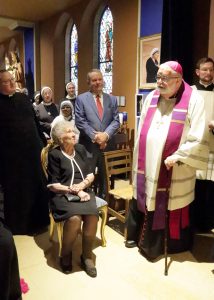
Archbishop Sheen’s niece Joan Sheen Cunningham looks on as Bishop Jenky addresses the small group that witnessed the interment at St. Mary’s Cathedral in Peoria on June 27. (The Catholic Post/Jennifer Willems)
Msgr. James Kruse, vicar general of the Diocese of Peoria, observed that the first day the public will visit the new tomb is on the seventh anniversary of that declaration. And noting the new tomb’s location beneath an icon of Our Lady of Perpetual Help, he called it “truly miraculous” that the transfer took place on the feast day for Mary under that title.
“That was unplanned,” said Msgr. Kruse. He expressed gratitude that the logistics of the day — including a flight from New York to Chicago and the driving of the remains to Peoria — went smoothly.
“Some of the earlier rancor during the litigation was not present at the New York cathedral today,” said Msgr. Kruse. “There was a spirit of joyful cooperation and real historical significance.”
Above and to the left of the new tomb is a plaque listing key dates in Archbishop Sheen’s life. At right is a representation of his coat of arms and episcopal motto, “Da Per Matrem Me Venire” (“Grant that I may come [to You] through the mother [Mary]”). Placed atop the tomb was an image of the archbishop engraved in glass as well as another of the intials “J.M.J.,” which he would scrawl on a blackboard at the start of his television programs to honor Jesus, Mary and Joseph.
In his book “Treasure in Clay,” Archbishop Sheen wrote that he hoped someone would put “J.M.J.” on his tombstone.
“He has come home,” said Msgr. Richard Soseman, who oversaw early research into Archbishop Sheen’s sainthood cause and is now its vice-postulator. “He’s back where he started. What a beautiful thing to have this happen just before the 100th anniversary of his ordination in September.”
“Let us rejoice on this blessed and happy day,” said Bishop Jenky, telling the seminarians present “that when you are old senior priests you can tell the story of the day Fulton Sheen was put in our cathedral.”
EDITOR’S NOTE: More photos from the interment at St. Mary’s Cathedral have been posted to The Catholic Post’s site on Facebook.





